
JAMES R. ARNOLD
TET OFFENSIVE 1968. TURNING POINT IN VIETNAM
The Imperial City of Hue was the most venerated place in Vietnam. The stone walls of its inner citadel had been built with the aid of the French in the 1800s. Peking's Forbidden City had served as the model for Hue's citadel. Thus it was a place full of gardens, moats and intricate stone buildings. Standing above the citadel was the highest flagpole in South Vietnam, as such, the most visible symbol of the South's struggle for independence. Communist planners did not overlook what was, with the clarity of hindsight, such an obvious target.
The war had not touched Hue, yet it was more than a symbolic target. A rail and highway bridge crossed the Perfume River and continued north. They served as the main land supply routes for the growing number of Allied troops along the DMZ. Hue also served as a major unloading point for waterborne supplies that were brought from Da Nang on the coast.
The attackers possessed very detailed information about Hue. They had divided the Right Bank into four tactical areas and had pinpointed nearly every civil and military installation. Viet Cong intelligence officers had prepared a priority list of 196 targets and had listed individuals to be captured. The plan called for their evacuation if possible; otherwise they were to be killed. In addition, 'Cruel tyrants and reactionary elements' - categories encompassing most South Vietnamese officials, military officers, politicians, Americans and foreigners except the French - were to be separated, taken outside the city and 'punished' - meaning killed. The Viet Cong carefully laid the groundwork for what became their most horrific atrocity.
On 30 January, a US Army radio intercept unit overheard Communist orders calling for an attack on Hue that night. Following standard procedure, it forwarded the message through channels. The Hue defenders did not receive the message in time. It was another in a long list of intelligence failures relating to the Tet Offensive.
Inside the city, Brigadier General Ngo Quang Truong, the commander of the 1st ARVN Division, had received Westmoreland's alert calling for cancellation of the cease-tire. Considered one of the best South Vietnamese generals, Truong gathered his staff at his HQ compound and kept them on 100 per cent alert. This vigilance paid dividends when the enemy attack struck. But over half his division's manpower still received holiday leave. Furthermore, given Hue's record as an 'open' city, Truong did not think the Communists would attack the city itself. He positioned his battalions to defend outside the urban area. Here too was a failure in preparation.
When the attack came, the only regular garrison comprised the all-volunteer Hoc Bao (Black Panther) Reconnaissance Company, 1st ARVN Division. They guarded Truong's HQ in the northern corner of the citadel. Scattered throughout the rest of the city were support troops. Across the Perfume River was the South Side, where a Military Assistance Command Vietnam (MAC A) compound housed American and Australian advisers and staff. These two strongpoints were to become islands of resistance when the 12th VC and Hue City VC Sapper Battalions, two NVA infantry regiments, and a rocket battalion flooded the city.
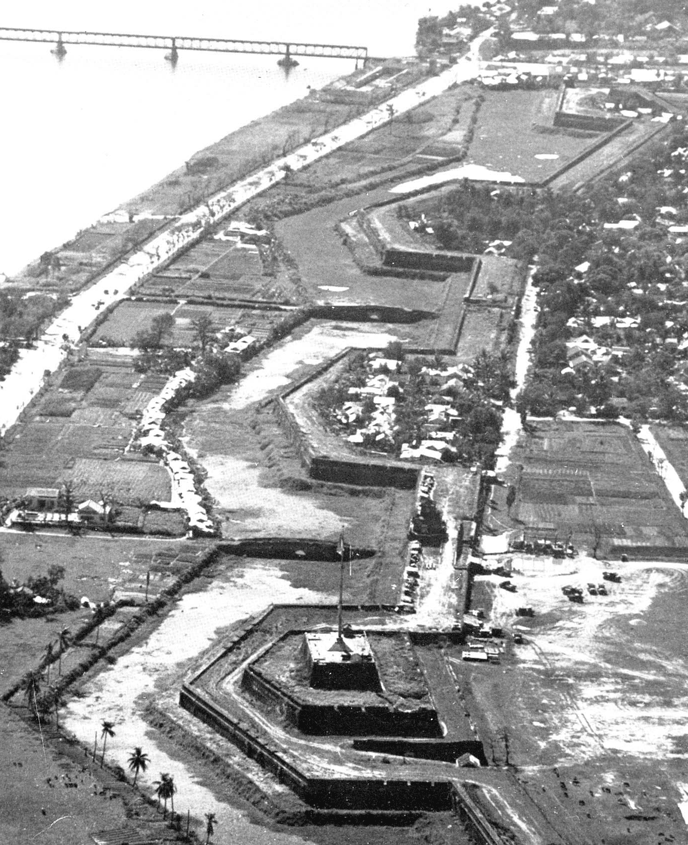
Surrounded by rows of thick-walled masonry houses, with many streets too narrow to permit access by Marine armour, the Citadel at Hue was a difficult position to even approach. Tall trees and hedgerows limited visibility to 25 yards. With two weeks to prepare, the defenders dug hundreds of camouflaged, mutually supporting positions rendering the Citadel an extremely tough objective. The old fortress and flag tower, from where the Communist banner flew during the long battle.
At 2am, 31 January, one of Truong's outlying patrols reported at least two enemy battalions advancing on the city. Apparently the Tet-induced torpor prevented him from making much use of this warning. In any event, he did not notify his allies at the MACV compound. They first learned of the enemy's presence an hour and forty minutes later when a dozen 122mm rockets detonated in their compound. Additional rocket and mortar bombardment provided preparatory fire while local VC, who had already infiltrated Hue dressed as civilians, took up positions to await the arrival of NVA assault troops hurrying into the city.
The Communists mistimed their first assault on the MACV compound. Instead of following on the heels of the rockets, they waited some five minutes. This gave the defenders just enough time to gather weapons and man defensive positions. A brave army soldier purchased another five minutes by manning an exposed machine-gun position atop a 20-foot wooden tower built on the compound's walls. His fire stopped the first rush of some forty NVA soldiers belonging to the 4th Infantry Regiment, who tried to advance to the walls to set satchel charges. A B-40 rocket round toppled him from his perch and allowed the attackers to storm the gate. Here they encountered some US Marines manning a bunker. They too slowed the attack until falling to a hail of RPG rounds. The time bravely bought allowed the defenders, including a tough crew of Australian warrant officers, to form a cohesive defence. The enemy changed tactics and tried to subdue the garrison with mortars and automatic weapons fire delivered from overlooking buildings. Isolated, unaware that enemy attacks had exploded nation wide, the garrison hunkered down and prayed for help.
All around their compound, and across the river, the 4th and 6th NVA Regiments and their VC comrades controlled most of the city and were freely roaming the streets. While the combat soldiers began fortifying mortar and machine-gun positions, special operatives began rounding up the people on their numerous lists. From atop the Citadel flagpole, a huge red-blue-gold Viet Cong flag flew. It had taken about two hours for the Communists to capture Hue, the country's second largest city.
Eight miles south of the city was the US Marine Corps Phu Bai Combat Base. Here the assistant commander of the 1st Marine Division, Brigadier General Foster LaHue, sifted through reports telling him of enemy activity throughout his area of responsibility. Included in the reports was one sent by the beleaguered defenders of the MACV compound, which had slowly drifted through the chain of command. Having been filtered by so many command levels, it conveyed little sense of urgency. Amid the confusion, Lallue apparently failed to appreciate both the scale and the critical nature of events in Hue. But, responding to orders, he did send reinforcements. Two and a half platoons belonging to 'A' Company, 1/1 Marines, boarded trucks and headed for Hue, not knowing that close to a full division of enemy soldiers awaited them.
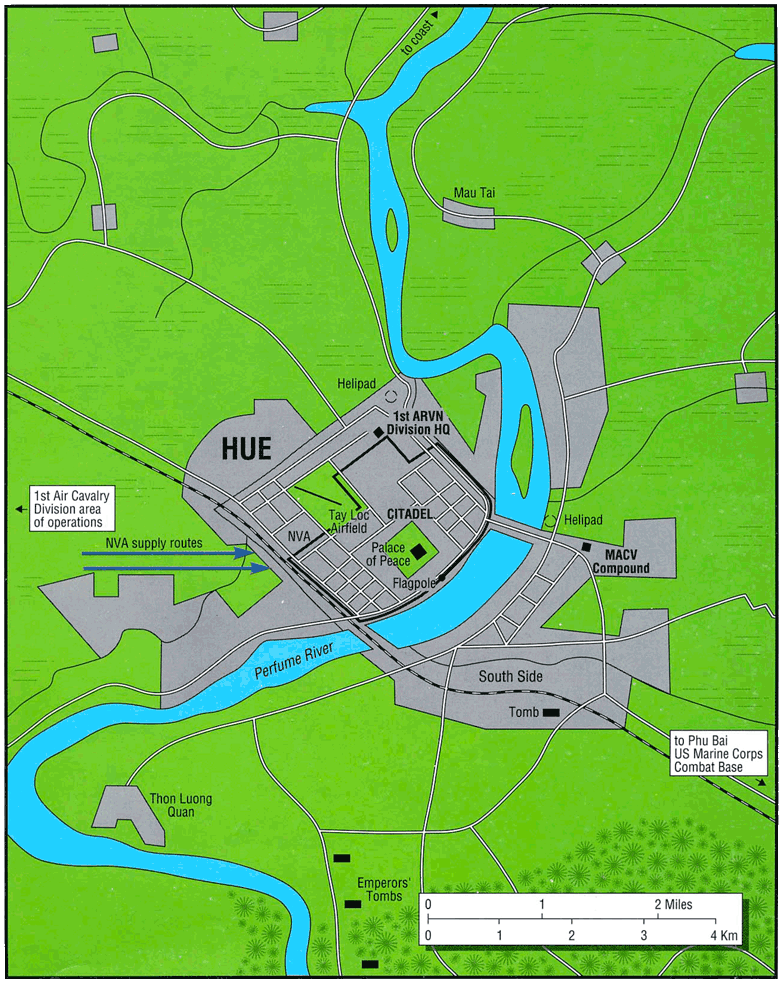
Hue
Fortunately, the Marines married up with four M-48 Patton tanks along the way. As the small convoy neared Hue's outskirts, Communist marksmen opened fire and wounded several grunts. The convoy ran the gauntlet of fire, crossed a teetering canal bridge that enemy sappers had partially destroyed and approached a cluster of buildings. They reminded the company commander, Captain Gordon Batcheller, of an old western town, two-storey wooden buildings with no sidewalks, and - most ominously - with no people. The captain ordered his men out of the trucks and on to the tanks. Then, in best Marine Corps tradition, he boarded the lead tank and ordered the advance. From the tank decks the grunts sprayed the buildings with fire as they drove by. In return came a tremendous volume of AK-47 fire and volleys of RPGs. One RPG thudded into the leading tank spraying Batcheller with shrapnel and cutting the legs off his radioman. The survivors gathered along a ditch and tended their wounded. From adjacent buildings and rooftops Batcheller could see NVA infantrymen firing at his unit. It was very different from the paddy and jungle war where one seldom saw the enemy. Alpha Company needed help.
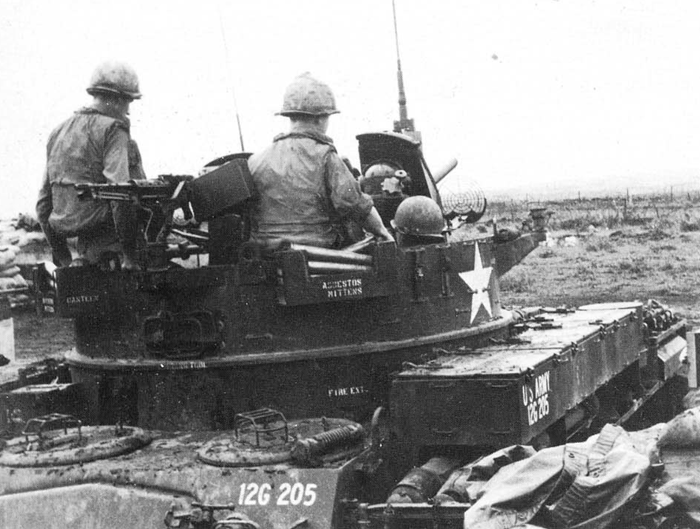
Joining the 'A' Company convoy were two Army 'Dusters', 40mm antiaircraft weapons used with deadly effect against ground targets.
Around noon the commanders at Phu Bai learned of 'A' Company's plight. Lieutenant Colonel Marcus Gravel received the mission of taking another company, Golf 2/5, forward to retrace Alpha Company's steps and try to relieve them. He had no information other than Alpha Company was pinned down. Naked valour would have to substitute for preparation, firepower and tactics. Although the NVA would ambush, with dismal regularity, most of the convoys that drove along the road to Hue, this group made it without incident. They joined Alpha Company's survivors, now led by a wounded gunnery sergeant, and fought their way towards the MACV compound. A dug-in NVA machine-gun opened fire. Although already wounded, Sergeant Alfredo Gonzalez crawled towards it along a roadside ditch. Drawing near, he tossed a grenade into the position and silenced the machine-gun. The advance continued to the MACV compound. One of the defenders was to recall: 'I have little doubt that many of us would not be alive today, had those Marines not arrived.'
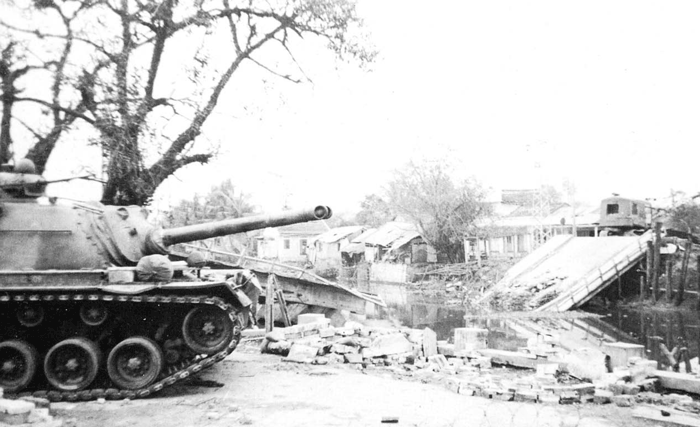
Marine Corps Patton tanks helped the grunts edge their way forward through Hue's streets. In officer recalls that the tanks drew heavy enemy fire: 'The moment a tank stuck its nose around the corner of a building, it looked like the Fourth of July' such was the volume and variety of hostile fire. One tank received 121 hits and went through five crews. Survivors came out looking 'like they were punch drunk'. This Patton halts before a destroyed canal bridge in Hue.
Once the objective had been attained, helicopters arrived to take out the many wounded. Then Gravel's two much-reduced companies received new orders from LaHue. He was to drive across the Perfume River, through the Citadel, and link up with General Truong in the 1st ARVN Division compound. Gravel protested to no avail. LaHue radioed back: 'Proceed.' Sadly, headquarters was out of touch with reality and would remain so for far too long. The misguided effort inevitably failed. The advance reached half way across the Perfume River bridge when NVA machine-gunners opened fire. Ten Marines fell dead or wounded in the opening volley. Golf Company pressed on, only to be ambushed in the narrow, winding streets bordering the Citadel. Gravel ordered an unauthorized retreat. Fifty of Golfs 150 men had been killed or wounded. That night, Gravel raged against the foolish orders that had sent his men to their doom. The only thing he felt thankful for was that the NVA had made a mistake too. Instead of holding fire just a little longer, which would have drawn Golf Company hopelessly into the maze of streets near the Citadel, they had shown their inexperience and fired too soon. The thought that the other side made mistakes provided some comfort as the two depleted companies manned a defensive perimeter around the MACV compound on the South Side.
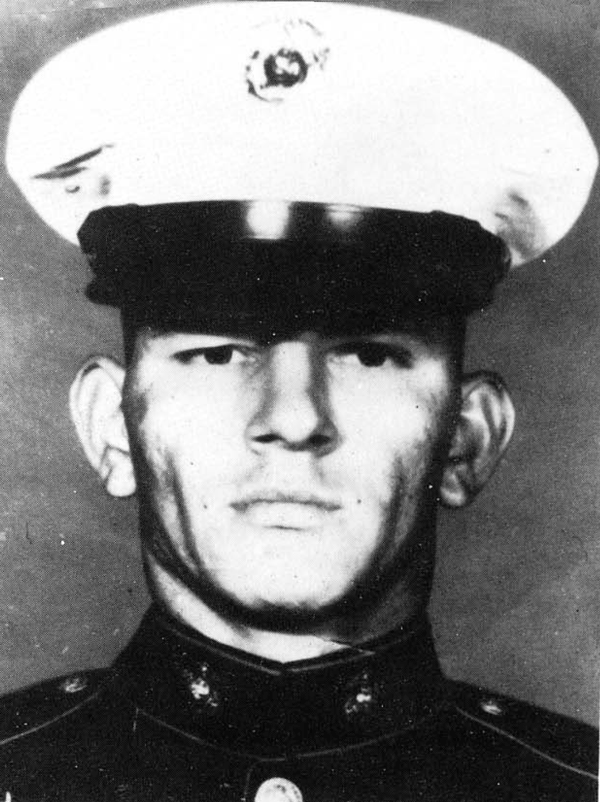
Pin toon Sergeant Alfredo Gonzalez, 21 years old, served with Alpha Company during its ambush on 31 January. When his unit suffered intense enemy fire, and although wounded from multiple shrapnel hits, Gonzalez rushed through the kill zone to rescue wounded Marines and drag them to shelter. Later in the action, he crawled along a roadside ditch to hand-grenade an enemy machine-gun that continued to pin his unit down. Four days later, having refused medical evacuation, while fighting through the Joan of Arc School, Gonzalez kicked in a door and led the rush into a school room. The NVA fired a hail of RPGs from point-blank range across the courtyard. The sergeant returned the fire with LAW rockets and silenced the enemy position. Suddenly a last enemy rocket entered the room striking Gonzalez in the midsection. Called 'the perfect Marine' by his officer, Gonzalez received a posthumous Medal of Honor for his conduct on 31 January.
The successful defence of the MACV compound on the South Side, and the concurrent defence of the 1st ARVN Division HQ compound in the northern part of Hue unhinged Communist defensive plans. Helicopters could, and did, land reinforcements at these two points. Both then served as bases from which to begin the counterattack to recapture the city. Instead of having a secure perimeter along fixed lines, the Communists had to defend against multiple threats including eruptions from within what they had thought would be their defensive perimeter. This was the significance of the gallant defence of the two strongpoints during the initial terror filled hours of the Tet Offensive. It also highlights the importance of the successful relief drive by the two Marine Corps companies during the first day.
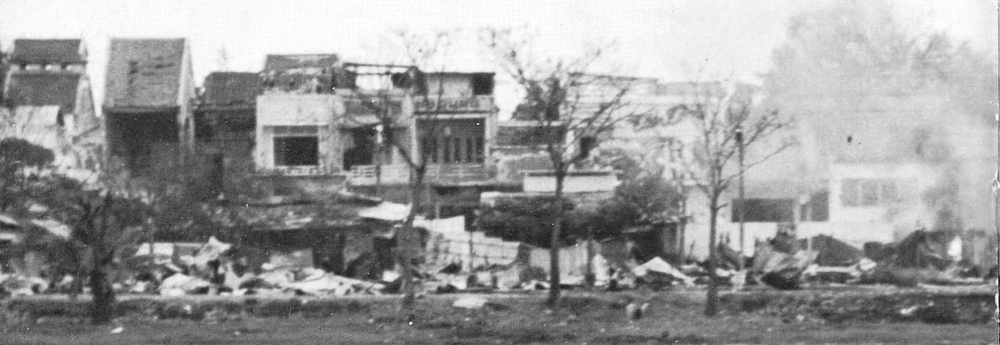
A Marine observation plane makes a low-level pass over the Perfume River. Lieutenant Colonel Gravel's Marines successfully assaulted the river but could not expand their bridgehead on the far side.
One of the first Communist targets had been the jail, housing some 2,500 inmates. After liberation, about 500 of them joined the attacking forces. The attackers also captured numerous American-made weapons when they seized the ARVN armoury during their opening assault. This, together with their ability to keep an open supply line from the A Shau valley, some 30 miles to the west, meant that the Communists were heavily armed and possessed ample ammunition. In addition, five reinforcing battalions joined the nine that made the initial assault. The weather too aided the Communists. Recurring misty drizzle greatly hampered Allied airpower. However, the rigid Communist plan could not adapt to the changed circumstances caused by the two Allied strong- points within their lines. Instead of making a major effort to eliminate these positions, the attackers yielded the initiative, dug-in and awaited the Allied counter-attack.
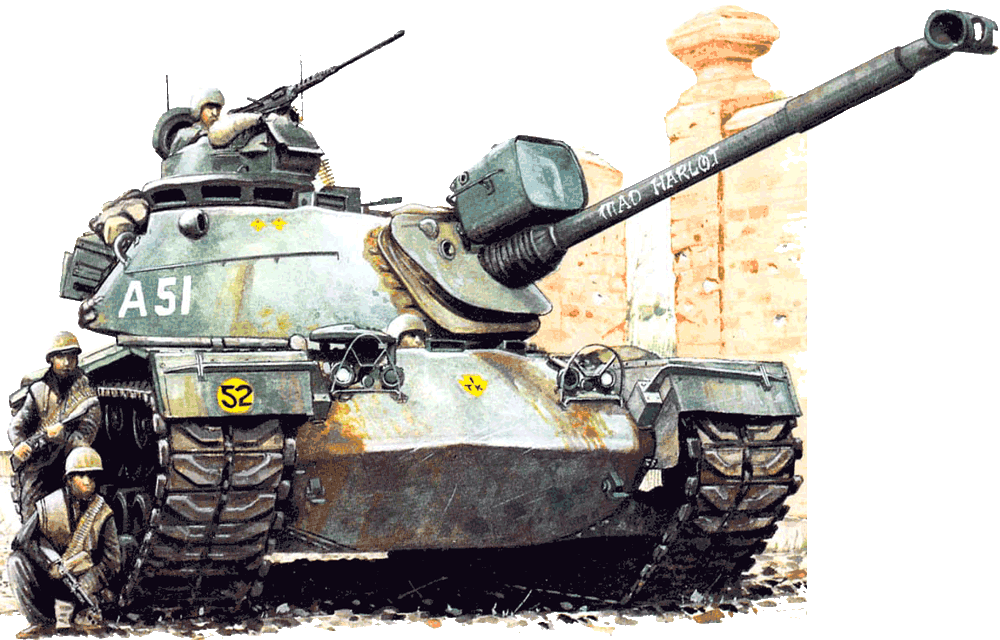
M48A3 Patton tank of 1st Tank Battalion, USMC, Hue. Illustration by Peter Sarson and Tony Bryan.
The second day in Hue, 1 February, established the pattern for the remainder of the battle. The generals, from LaHue on up, spoke in terms of 'mopping-up' and 'pushing the VC out of Hue this morning'. Meanwhile, three Marine companies, eventually reinforced by a fourth, began a building by building struggle through an eleven by nine block area to clear the South Side. Even alley, street corner, window, and garden wall harboured potential death. The only way to advance was to blast an entrance with bazooka or recoilless rifle lire and then send fireteams and squads into the breach. To charge through a blow-in door, clamber over an exposed garden wall, or sprint across an intersection required great bravery. The Marines' special espril de corps motivated the 18- and 19-year-old grunts to do these things and more, repeatedly, for nearly a month.

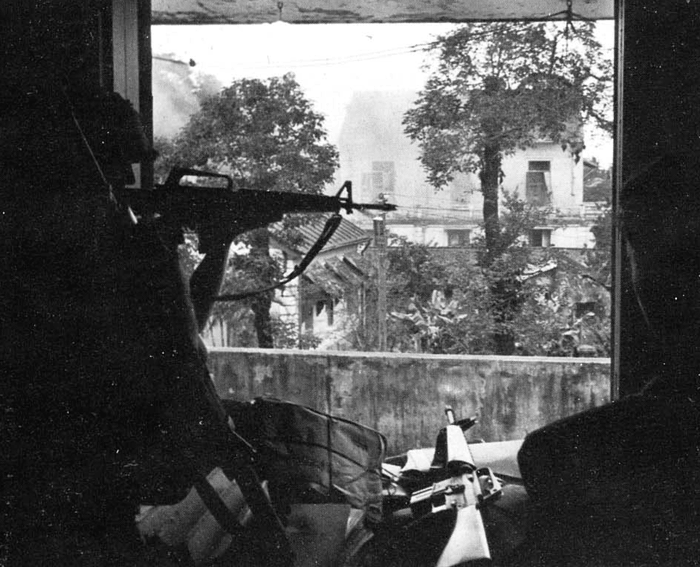
After fighting up a street, through a garden and into a house against tough resistance, a Marine officer who had led the charge took time to inspect the enemy position. He found two-foot-thick concrete walls with bunker-style firing slits. The slits provided a perfect field of fire down the street and into the building from where the Marines had staged the assault. Stepping back, the officer could only mutter: 'Son of a bitch, son of a bitch.'
In times past, a wounded Marine expected to receive medical evacuation and an extended recovery period. In Hue, those suffering from any but the most disabling wounds commonly were patched up by medical personnel and voluntarily returned to duty. A company leader later wrote: 'I had several men who had shrapnel in legs and arms and hobbled around and begged me not to medevac them.' Another officer thought that 'it was payback time' for the Marines who had endured prior months of sniper fire and booby traps without being able to hit back. The presence of even rifle-wielding grunt was badly needed. Since the High Command seriously under-estimated their opposition, the attackers received paltry reinforcements. For most of the long battle, a mere two understrength battalions conducted the advance. A frustrated battalion commander wondered: 'Why must they always piecemeal us into battle?'
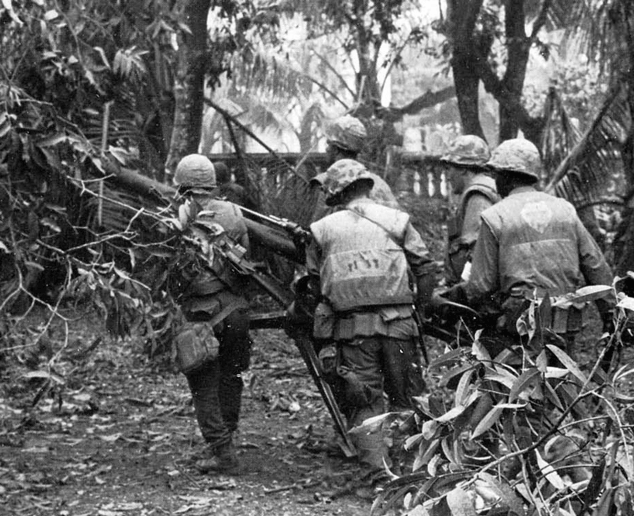
Flak-vested 1st Regiment Marines move a 106mm recoilless rifle into position to open the way through the next block of buildings during the house-to-house fighting in Hue.
While the Marines operated on the South Side, Lieutenant General Hoang Xuam Lam worked to recapture the Citadel. He planned to use the 1st ARVN Division HQ's perimeter as a base of operations. First he needed to send reinforcements, and this proved very hard. The 7th ARVN Armored Cavalry and two airborne battalions had to force a convoy through a major ambush to reach Hue. Similarly, two battalions of the 1st ARVN Division's 3rd Regiment took fearful losses during their approach march. During 1 February, the 2nd ARVN Airborne Battalions and the 7th ARVN Cavalry recaptured Tay Loc Airfield, but only after suffering heavy losses including twelve armoured vehicles and the death of the cavalry squadron commander. Facing resistance even bit as tough as that confronting the American Marines across the river, the South Vietnamese slowly advanced through well-prepared fortified positions. By 4 February, a battalion of the 3rd ARVN Regiment - a regiment that would consistently fight harder than any other ARVN formation and take crippling losses as a result - stormed the An Hoa gate taking the Citadel's north-west wall. This effort consumed the aggressive spirit of the airborne and regular ARVN forces. On the night of 6 February, a ferocious nocturnal NVA counter-attack by storm troops using grappling hooks drove the ARVN forces from the recently recaptured south-west wall.
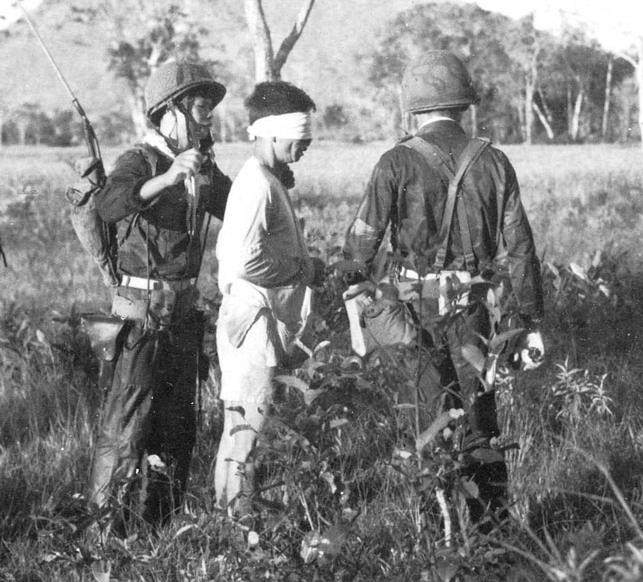
The Americans tended to denigrate the combat skills and bravery of their South Vietnamese allies. After-combat reports and subsequent history focused on actions featuring Americans. However, ARVN forces took the brunt of the Tet Offensive and their losses reflected this. In Saigon alone, while the American attention focused on the Embassy, racetrack and Tan Son Nhut, on the first day of battle 88 ARVN soldiers died and 239 were wounded. The elite Airborne, Ranger and Marine units suffered most of these losses. ARVN Airborne soldiers with a captured Viet Cong. In Hue the American Marines felt badly let down by the lack of contribution from the ARVN. Said one: 'The ARVN were an unruly lot and they made sure to stay far to the rear of the advancing Marines... We'd see them after a pitched battle, driving up in trucks to loot the buildings we had just captured... I think if the ARVN ever enjoyed any fighting reputation with the Marines, they lost it in Hue.'
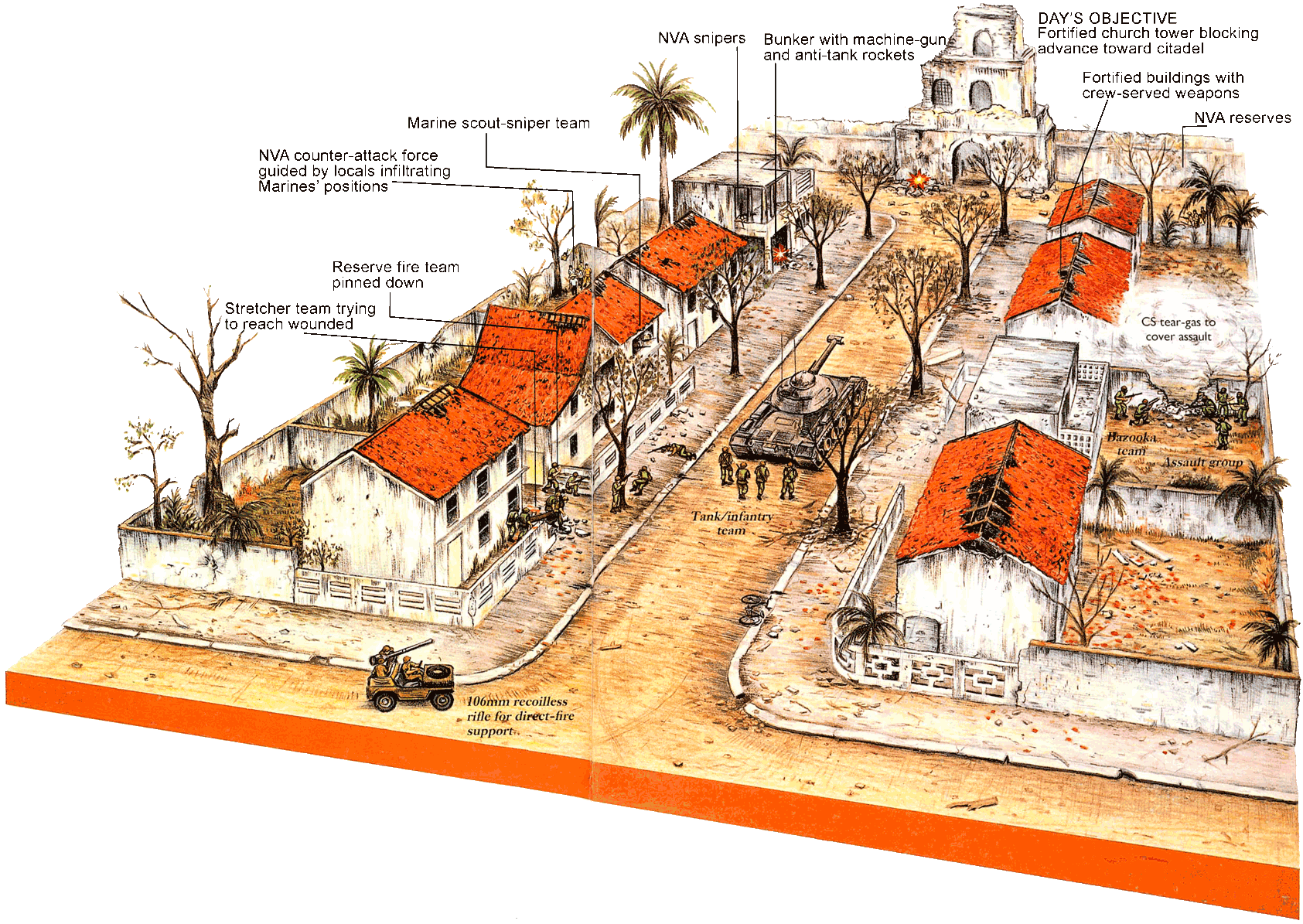
STREET FIGHTING IN HUE
1-27 February 1968. Typical urban combat scene as US and ARVN forces battle with NVA and VC units for control of the city.
The battle for the old Imperial Capital of Hue began on 31 January and continued until 2 March 1968. In a guerrilla war, Hue was an exception, an extended urban combat against a foe who tried to hold fixed objectives. The battle featured two NVA regiments backed by two VC sapper battalions against eight US and thirteen ARVN infantry battalions. The urban landscape denied the Allies their two greatest weapons — mobility and firepower. The battle became a savage small-unit house-to-house combat. After the first few days, the ARVN units had spent their impetus. It was left to the Marines to recapture Hue.
Aided by local sympathizers and impressed civilian labour, the defenders turned each block into a fortress. They sited crew-served weapons at doorways and windows to sweep the streets; they used back alleys and lanes to hasten reinforcements to threatened sectors and to launch sudden, unexpected counter-attacks.
For the attackers it was a battle of fire-team rushes. Battle-scarred Patton tanks operated in the main street, but in these confined areas they were unmistakable targets for NVA machine-guns and RPGs. Holed repeatedly, the tanks would withdraw briefly. The dead and wounded crew were removed, replacement crews installed and the tanks returned to combat. Many tanks went through several crews a day.
Behind them came the flak-vested grunts. Working in close coordination with the tanks, they methodically reduced the Communist positions and clawed their way forward. From adjacent buildings, Marine scout-sniper teams tried to eliminate Communist snipers while providing covering lire for the grunts in the street. Deadly man-to-man sniper duels ensued.
Jeep-mounted recoilless rifles and Ontos anti-tank vehicles gave direct-fire support. Lightly armoured, they utilized bold hit-and-run tactics. They would appear suddenly around a debris-clogged corner, lire, and then dash for cover.
When assault up the main streets proved impossible, Marine fire-teams manoeuvered through back alleys to attack from the rear. Numerous garden walls and hedgerows made such tactics difficult. To work up courage for the assault, many Marine teams chanted in unison as they awaited the signal to charge. A bazooka round provided this signal when it blasted a hole in the masonry wall separating one garden from another. Then the assault teams rushed through the breach. Too often the first through the breach fell to the defender's withering automatic weapons fire.
Both sides utilized CS tear gas rounds. Thus the battle was one of the few of the war where the presence of gas forced the combatants to fight wearing gas masks. Hue was urban combat at its worst. A day's advance was measured in yards.
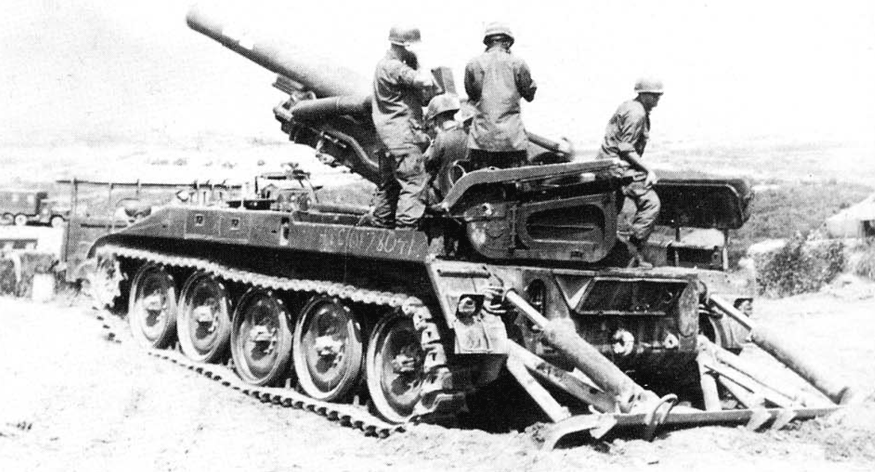
Meanwhile, outside Hue, a battalion of the hard- fighting 1st Air Cavalry Division air-assaulted into the middle of the Communist supply line in an effort to interdict the flow of supplies to Hue. Attacking through the fog, 2/12 Cav had to do without its customary helicopter gunship and aerial rocket artillery support. Confronted with two dug-in NVA battalions, the cavalry failed and retired to prepare against the expected counter-attacks.
At dawn a heavy mortar barrage landed within the 150-yard-wide battalion perimeter. Charging NVA infantry, firing their AK-47s from the hip and supported by numerous machine-guns giving grazing support fire, followed the bombardment with repeated assaults. Only accurate defensive fire from a 105 mm battery preserved the position.
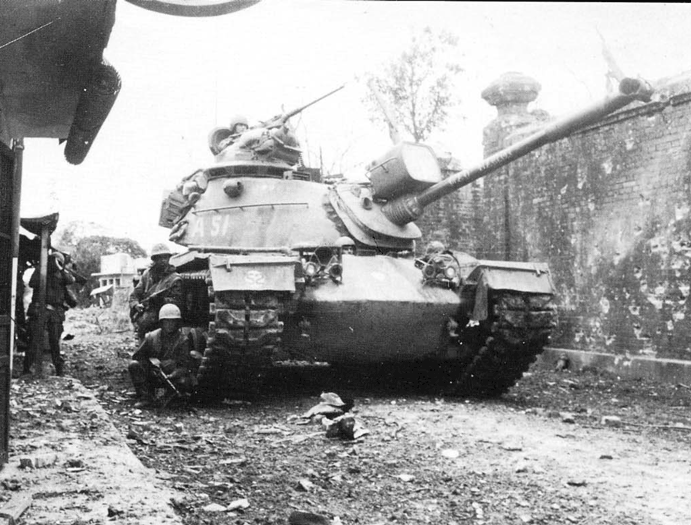
Prohibitions on the use of artillery, such as the very accurate 8-inch howitzer, made the recapture of Hue even more difficult. The Allies had to retake Hue one building at time.
As the afternoon wore on, casualties mounted as mortar rounds scored direct hits within the crowded perimeter. The cavalry's ammunition ran low. Medevac helicopters were able to rescue only the most seriously wounded in the face of heavy Communist fire. As nightfall approached, the battalion commander, Lieutenant Colonel Dick Sweet, realized that his isolated unit could not hold out. Sweet made a bold decision. Rather than await the final NVA assault, his unit would break out from their perimeter. Furthermore, instead of heading in the expected direction toward the nearest friendly unit, the cavalry set out across an exposed rice paddy. The most reliable point man led the way. As Private Hector Comacho recalls: 'It was dark, but I trusted myself. The hardest part was finding some place where everyone could go, and making sure that everyone could keep up.' Officers instructed the troopers not to fire under any circumstances, and if they received fire they were to hit the ground and remain silent. Sweet recalls the march: 'We had men who had refused to be medevaced that afternoon. They hid their wounds so they could stay with the battalion... You'd see them limping; there was no talk. No noise at all. I've never seen such discipline in a unit... You'd find that the man up ahead of you who was dragging a foot had a bullet in his leg, and had it there for almost 24 hours. That's why the night march worked.'

A Pat ton tank supports the 1/5 Marines beside the citadel walls on 12 February.
Eventually the Air Cav was able to isolate Hue from outside reinforcements. Some 6,000 defenders held Hue for nearly a month. When it was all over, American commanders speculated what would have happened had the enemy sent one of the big 10,000-man divisions stationed along the DMZ into Hue. West-moreland's replacement, Lieutenant General Creighton Abrams, thought he knew. In 1969 he told a reporter: 'We'd still be fighting there.'
Taking all their wounded with them, the troopers trudged through a rainy, cold, pitch-black night. After a perilous eleven-hour march, 2/12 Cav arrived atop a low hill from where they could receive helicopter resupply. It had been exceedingly well done, but still the cavalry had failed to shut off the Communist flow of supplies into Hue.
We have much more interesting information on this site.
Click MENU to check it out!
∎ cartalana.com© 2009-2025 ∎ mailto: cartalana@cartalana.com